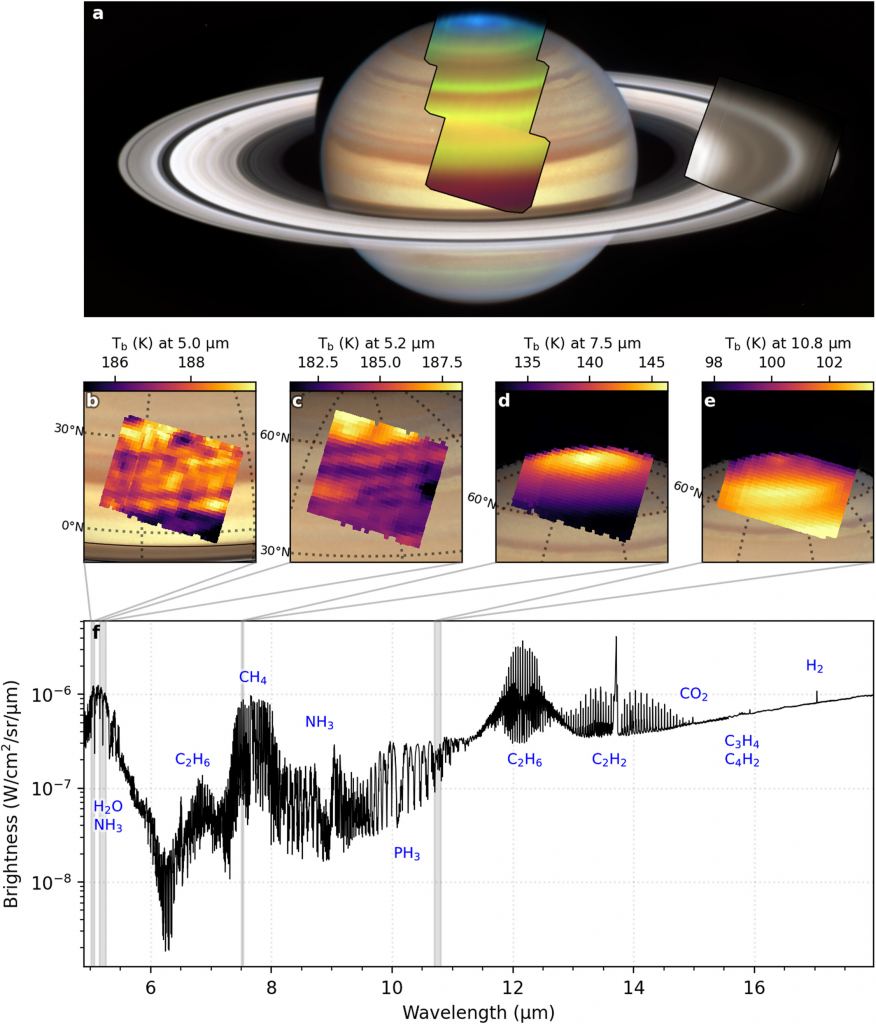Just like Earth, Saturn goes through seasons because of its axial tilt. But a year on Saturn lasts 30 Earth years, so each of its seasons lasts 7.5 years. Right now, it is late summer on Saturn's northern hemisphere, so again, just like Earth is currently heading for northern autumn equinox in September, Saturn is heading for northern autumn equinox a little later, in 2025.
Before Saturn's north pole enters its extended polar winter – rendering it inaccessible for observations -- astronomers are taking advantage of being able to study this area with the James Webb Space Telescope, which became operational just over a year ago.
The infrared capabilities of JWST's instruments are providing new, never-seen-before insights into the changing seasons on the massive ringed planet, showing how the seasonal shift on Saturn affects the planet's climate.
The unique image shows spectroscopic views from the Mid-Infrared Instrument (MIRI) showing Saturn's waning summer hemisphere, helping researchers to study the seasonal evolution of temperatures, aerosols, and composition.
"We wanted to explore how Saturn's atmosphere responds to the changing seasons as northern summer comes to an end," said Leigh Fletcher, from the University of Leicester, who led the observations, in a post on X (formerly Twitter). "We see a reversal in the circulation patterns that Cassini witnessed during northern winter."
The Cassini spacecraft orbited Saturn from 2004 to 2017, which was during the planet's northern winter and spring.
The MIRI instrument splits the infrared light into its component wavelengths allowing scientists to see the 'fingerprints' of the rich variety of chemicals within a planet's atmosphere. In their paper, published in JGR Planets, the team wrote, "MIRI's high sensitivity enables the first identification of previously unseen emission propane bands, along with the first measurements of the distribution of several gaseous species: tropospheric water, and stratospheric ethylene, benzene, methyl, and carbon dioxide."
Loading tweet...
— View on Twitter
The image and the video posted by Fletcher shows various JWST wavelengths and structures from different layers of the atmosphere. Saturn's banding shows up in tropospheric wavelengths and the warm polar vortices show up as blue in stratospheric wavelengths. The glowing polar vortices and contrasting temperature bands are superimposed onto a Hubble image from 2022.
The researchers said they see evidence that the stratospheric circulation pattern detected by Cassini during northern winter has now fully reversed in northern summer. The data also show evidence for changing temperatures and winds in the equatorial region, polar vortices, and interhemispheric stratospheric circulation.
By modelling the mid-infrared spectra, the scientists noticed how different the distributions of stratospheric temperatures and gases were now as compared to Cassini's observations. Saturn has a large-scale stratospheric circulation pattern with warmer temperatures and excess hydrocarbons, like ethane and acetylene in the northern midlatitudes in winter, signifying sinking of hydrocarbon-rich air from above. Air was thought to rise in the southern summer midlatitudes, cross the equator, and sink into the northern winter midlatitudes.
MIRI spectral coverage and sensitivity enables mapping of several gases for the first time, particularly in ranges inaccessible to Cassini
"JWST can see in wavelengths of light that were inaccessible to any previous spacecraft, producing an exquisite dataset that whets the appetite for the years to come," said Fletcher, in a press release from the University of Leicester. "The quality of the new data from JWST is simply breath-taking – in one short set of observations, we've been able to continue the legacy of the Cassini mission into a completely new Saturnian season, watching how the weather patterns and atmospheric circulation respond to the changing sunlight."
Fletcher added that he and his team started designing these Saturn observations with JWST more than 8 years ago, and when the first data landed came back from observations in November 2022, Fletcher said it was a career highlight.
These observations, early on in JWST's operational tenure -- were also a test of the telescope's capabilities. The researchers said there was definitely a learning curve for learning how to make the most of their observation time.
"Because it is big, bright, rotating, and moving across the sky, it provides a challenge for the small fields-of-view of the MIRI instrument, " said Oliver King, a postdoctoral researcher at Leicester and co-author of the study. "MIRI can only see a small area of Saturn at any one time, and we're at risk of saturating the detectors because the planet is so bright compared to JWST's usual targets. The observations were taken as three tiles, stepping from the equator to the north pole, and then out to the rings for a final tile."
 Universe Today
Universe Today

